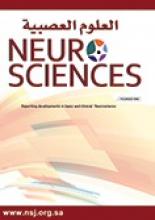Abstract
OBJECTIVE: To describe the prevalence and morphologic characteristics of the foramen arcuale of the atlas vertebra in the Saudi population and propose a simplified classification system.
METHODS: A cross-sectional hospital-based study was conducted at King Abdulaziz University Hospital, Jeddah, Kingdom of Saudi Arabia from September 2010 to February 2011. During the 6-month period, 453 CT studies of the cervical spine were evaluated for the presence of different degrees of this anatomic variant using a clinically relevant classification system.
RESULTS: We found 52.1% (236 patients) to have no degree of osseous bridging, 31.8% (144 patients) had some degree of incomplete posterior osseous bridging, and 16.1% had the complete form of the foramen arcuale. The anomaly showed a male predilection that only reached statistic significance for those on the left side (p=0.016). Patients with a well-developed variant were older than those without the anomaly, but only by 7.46 years (p=0.034). These anomalies showed a propensity for bilaterality, which is a source for concern (kappa=0.592, approximate significance=0.00).
CONCLUSION: Compared to data from other countries, this anomaly has a higher prevalence in our population, indicating that further investigations are needed.
- Copyright: © Neurosciences
Neurosciences is an Open Access journal and articles published are distributed under the terms of the Creative Commons Attribution-NonCommercial License (CC BY-NC). Readers may copy, distribute, and display the work for non-commercial purposes with the proper citation of the original work.






